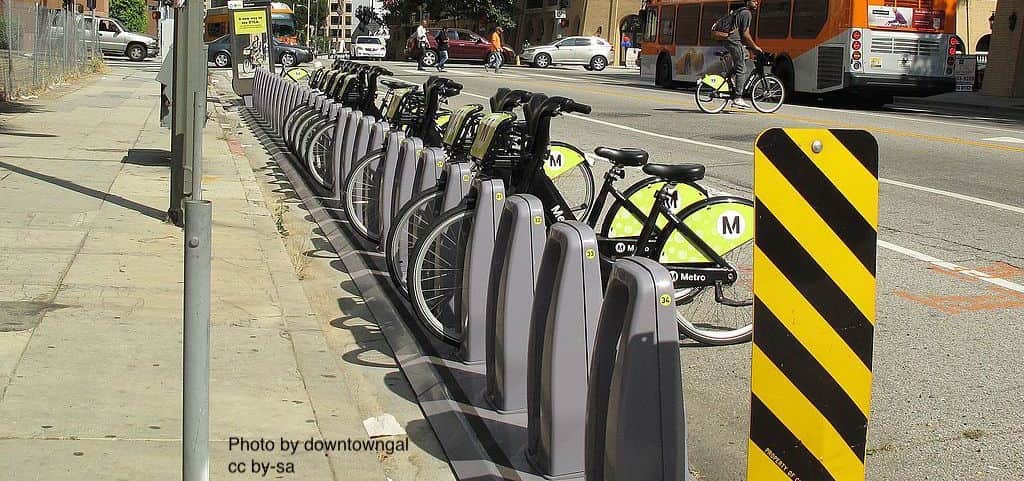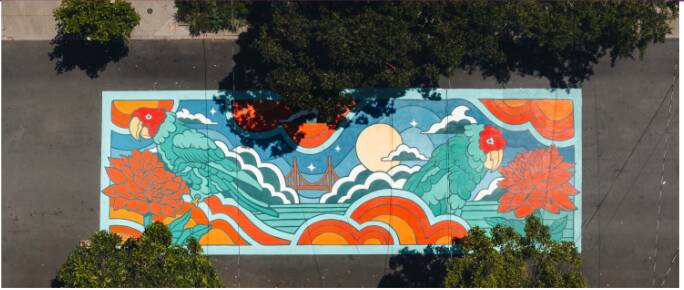On June 6, bills with any chance of becoming law this year left their house of origin. Senate bills had to pass a vote of the full Senate and move to Assembly committees for review, and vice versa. We’re happy to report that our two priority bills made it past the midway point, though one may face a tougher road in the Senate. Here’s the status of all the bills we’re supporting and following in the 2025 session.
Sponsored bills: Quick-Build and Bike Highways
Bills are often amended, watered down, or altered to meet the demands of various committee members and chairs in exchange for a yes vote. Our two sponsored bills made it through the Assembly with no changes, and we’re excited to support them through the process in the Senate.
Quick-build Caltrans pilot
Caltrans maintains many local streets, and they are often plagued with fast-moving traffic and few safety features for people biking or walking. The Quick-Build Bill (AB 891, Zbur) would increase Caltrans’ ability to use temporary measures to swiftly address known road hazards and implement Complete Streets upgrades. Local public works departments across California use quick-build methods to safely and inexpensively add protected bikeways, sidewalk bulbouts, and other safety features. The Quick-Build Bill will save money and time and bring this effective process to our state DOT.
Bike highways
The Bike Highways Bill (AB 954, Bennett) proposes a pilot project to create two regional bike highways. A bike highway can provide a connected network of safe, comfortable bikeways protected from car traffic that encourages more people to get where they need to go by bike, and we thank Assemblymember Steve Bennett for his leadership in championing this bill.
We were pleased to see the bike highway concept pass the Assembly with strong support, but it faces a tougher path in the Senate. Every bill that involves new expenditures gets extra scrutiny in a year like this, where California’s budget is squeezed. We feel our state’s transportation budget has more than enough funding to support this excellent project; this mode-shifting, visionary program is a better way to spend our transportation dollars than another freeway lane that will be clogged with standstill traffic in a matter of years.
In addition, bike highways don’t need to be built completely from scratch; Caltrans can start with existing networks of off-road paths and on-street separated bikeways. The bike highway network would close gaps, extend the network to common destinations, and engineer safe intersection crossings. Many local and regional agencies already have many bike highways in the planning phase — this statewide pilot can jumpstart those stalled projects. The Bike Highways Pilot will take years to put on the ground; its fate shouldn’t rest on one bad budget year or our ingrained practices of freeway expansion for cars. Please email the chair of the Senate Transportation Committee and voice your support for bike highways in California.
Fire service bill doesn’t move forward
CalBike rarely opposes bills, but we had to speak out against AB 612 (Rogers), which would have increased fire department authority over bikeway planning decisions. Too often, fire departments oppose new bikeways because they claim they will hinder access in case of a fire. Somehow, cars parked along the curb don’t create an obstacle for the fire department.
We appreciated the discussions that happened around this bill. And we’re encouraged by the efforts of Mike Wilson, who helped launch an innovative program in Berkeley to leverage the fire service’s expertise in prevention to take a preventative approach to street trauma. It’s a win-win for street safety advocates and fire departments, whose EMS staff are first on the scene to aid most traffic violence victims.
Bills we’re supporting
This year is the first year of California’s two-year legislative session, which means that some bills will become two-year bills. A two-year bill is put on pause this year and revived in January 2026, with a deadline to move forward before it’s declared DOA. The two-year option can be helpful if a bill needs more time or revisions to gather the support needed to pass. One of the 10 bills CalBike is supporting this year became a two-year bill, one died in the Assembly, and the rest have passed their first house. Here’s the status.
School Streets Bill (AB 382, Berman): This much-needed measure would lower the speed limit around schools from 25 mph to 20 mph. Even a few miles per hour can make a big difference in the severity of injuries when a car hits a pedestrian, and children are particularly vulnerable. This law will give drivers more time to see children and stop; it’s an excellent way to move California closer to Vision Zero.
Red Light Camera Reform (AB 720, Ashby): Automated enforcement for car drivers running red lights is legal throughout California but problematic, which has led some municipalities to abandon red light cameras. This bill seeks to reform the way red light cameras are regulated and tickets are issued to make the system more equitable and effective.
Intelligent Speed Assist for Dangerous Drivers (AB 981, Gipson): One of CalBike’s sponsored bills last year, Senator Scott Wiener’s SB 961, would have phased in intelligent speed assist (ISA) for all new vehicles. It passed the legislature, but the governor vetoed it. AB 981, which has become a two-year bill, is currently written as a pilot in Los Angeles, San Diego, Fresno, Sacramento, and Kern Counties. Drivers convicted of reckless driving would be required to install active ISA, much the way those convicted of drunk driving can be mandated to have ignition interlock devices that prevent them from driving drunk. Active ISA prevents a vehicle from going above the posted speed. We’re interested to see how this develops. The EU now requires ISA on all new vehicles, and we hope it will become a standard safety feature here in the near future.
Slower State Routes (AB 1014, Rogers): In 2021, CalBike helped pass AB 43, which gave California municipalities more flexibility to lower speed limits than the 85th percentile rule would have allowed. This bill extends the same option to Caltrans on state routes that aren’t freeways. Since these routes often run through neighborhoods — bringing dangerous, speeding traffic — this bill could represent a significant step toward safer streets.
License Plate Covers (AB 1085, Stefani): This bill would make manufacturing, selling, or using a cover that obscures the license plate number of a car illegal in California.
Caltrans Climate Change Vulnerability Assessment (AB 1132, Schiavo): This bill would have required Caltrans to identify what makes communities resilient to climate-caused transportation disruptions. It died in the suspense file.
Remove Bikeway Roadblocks Bill (SB 71, Wiener): Senator Wiener authored a bill during the pandemic giving active transportation projects a temporary exemption from CEQA, California’s environmental review law. This bill would make the CEQA exemption permanent.
Sustainable Transportation Permitting (SB 445, Wiener): This bill speeds up the permitting and construction of sustainable transportation projects, including bikeways. It will also allow communities to fix dangerous road segments more quickly, thus reducing the heavy toll of traffic violence.
Safe Crossings Save Lives (SB 671, Cervantes): This bill seeks to make traffic signals more pedestrian-friendly. To achieve this, it includes a requirement that California inventory existing pedestrian signals on state-controlled roadways to understand the existing condition. This will help direct funding and maintenance where they are most needed.
E-bike bills
With six bills relating to e-bike regulation introduced this year, they need their own category. Unfortunately, the bill we felt had the most promise died in the Assembly. The other five all passed their first house.
The one that didn’t make it
A bill to clarify the classification of some of the vehicles illegally sold as e-bikes (SB 455, Blakespear) fell victim to the dreaded suspense file in the Senate Appropriations Committee. The measure would have reclassified “e-bikes” with higher motor-assisted speeds than the 28 mph allowed under California law. It would have created a new class of motorized bikes, low-power mopeds, and moved some of these bikes into the current moped or motorcycle categories. This would have triggered registration and licensing requirements and prohibited dealers from selling them to underage riders. There was some pushback from the DMV, which would have a slew of new vehicles to register, and the motorcycle industry, which resisted having these bikes classified as electric motorcycles.
We think this measure had a lot of promise, and we’re grateful to Senator Catherine Blakespear for bringing stakeholders together to discuss this issue. CalBike will be convening stakeholders from a range of communities to discuss the future of e-bike regulation in the coming months, and we hope to pick up where this discussion left off.
E-bike bills moving forward
Two of the five remaining e-bike bills relate to classification issues, one places an age limit on e-bike sales, and two increase the penalties for e-bike violations. CalBike is watching these bills; we haven’t taken a position for or against them.
E-Bike Application Prohibition (AB 545, Davies): This measure prohibits the selling of applications that modify the speed capability of an electric bicycle. This bill is an extension of a bill last year (AB 1774, Dixon), which prohibited the selling of speed-enhancing devices.
E-Bike Confiscation (AB 875, Muratsuchi): This bill would clarify that police can confiscate the illegal e-motorcycles that are often sold as e-bikes, something some local jurisdictions are already doing. While these bikes aren’t street-legal and are subject to law enforcement, we don’t think the police need another pretext to stop and harass young people of color.
Penalizing E-Bikes (AB 544, Davies): E-bikes are required to have a red rear reflector or flashing light when operated at night, just like all bikes. This bill would require e-bikes to have this reflector or light during all hours. Current law requires minors to wear helmets on bikes or face a $25 fine. This bill allows a diversion if the minor takes the DMV’s online e-bike safety class and proves they have a helmet.
Class 3 E-Bike Sales Prohibition (AB 965, Dixon): This bill prohibits the sale of a new or used Class 3 e-bike to anyone under 16. Class 3 bikes use pedal assist only, with a top speed of 28 mph, and are already subject to more limitations than Class 1 and 2 bikes, which have a top speed of 20 mph. No one under 16 is allowed to operate a Class 3 bike, and all riders must wear helmets. Given those requirements, this measure seems superfluous, but that’s a theme in the e-bike legislation this year.
The eMoto Bill (SB 586, Jones): This bill creates a new eMoto classification, which would cover some of the vehicles currently sold as e-bikes that don’t fit the classification system. The devices classified as eMotos wouldn’t be street legal; they would be allowed for off-road use only.
Bills we’re watching
CalBike is watching 11 bills. We haven’t taken a position on these bills, but we’re monitoring their progress through the legislature because they could have an impact on active transportation.
In addition to the six e-bike bills listed above, we’re watching:
- State Building Standards (AB 306, Schultz/Rivas): This bill would freeze state, county, and city building codes in California for six years. It passed the Assembly and is in the Senate.
- Polluters Pay Climate Superfund Act of 2025 (AB 1243, Addis): This bill would establish the Polluters Pay Climate Superfund Program to be administered by the California Environmental Protection Agency to require fossil fuel polluters to pay their fair share of the damage caused by greenhouse gases released into the atmosphere. It has become a two-year bill.
- Regional Housing Needs and Transportation Plans (AB 1275, Elhawary): This bill would harmonize the regional housing needs allocation process with the regional transportation plan and sustainable community strategy processes to ensure the needs of both existing populations and projected populations are met, and to ensure local governments have plans for sufficient housing in climate-friendly locations near transit, jobs, and services. It passed the Assembly and is in the Senate.
- San Francisco Bay Area Local Revenue Measure (SB 63, Wiener/Arreguín): This bill would authorize the Metropolitan Transportation Commission to propose a revenue measure to the voters in its jurisdiction to fund the operation, expansion, and transformation of the San Francisco Bay Area’s public transportation system, as well as other transportation improvements. It passed the Senate and is in the Assembly.
- Study for Road and Safety Improvements (SB 78, Seyarto): This bill would require Caltrans to conduct a study to identify certain locations in the state highway system with regard to vehicle collisions, and projects that could improve road safety at each of those locations. It passed the Senate and is in the Assembly.
To stay up to date on the latest developments with all the bike-related legislation, check CalBike’s Legislative Watch page. Subscribe to our newsletter for regular updates on the most crucial bills for active transportation and periodic reassessments of the status of all the bills we’re supporting or watching.







